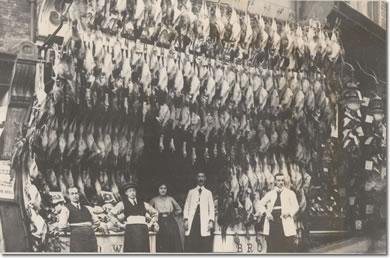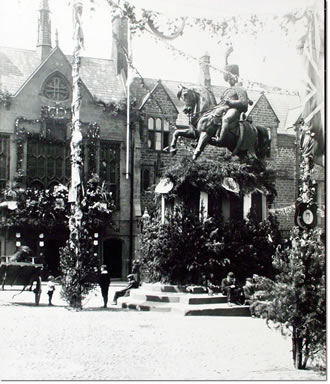
Why are photographs useful?
This seems like a really easy question to answer. Photographs are useful because they tell us what someone, something or some place looked like at any particular time. We can find out a lot of information from studying photographs very carefully. Look at this photograph for example. It shows a photograph of a poultry shop in Durham and dates from c1910. But what else can we tell just from looking at it? Well, we can see how shopkeepers displayed their items, what kind of clothes were worn by people working in shops etc etc. The important thing to remember when looking at photographs is to look at everything right down to the smallest detail.

Early 20th century photograph of the Miner’s Gala in Durham. (DUL ref: Gibby City/A/122).
There is a phrase that says “the camera never lies”. Is this true do you think? Well it is to a point. Think about when you have your school photograph taken. Do you look like this all the time? People can make a special effort to look their best in photographs. They might also use props or a nice background to make the photograph look better. Now we can also use computers to make photographs look better (or worse!). This doesn’t mean that we shouldn’t use photographs as evidence, we just need to be careful.

Photograph showing the shop front of Brown Bros, Silver Street, Durham, c1910. (DUL Ref: Gibby City/A/14)
Cameras have been around for centuries but it was not until the mid nineteenth century that a way of making permanent “fixed” images was discovered. The first person to do this was called Niepce in 1826. He called his images ‘heliographs’. The only trouble was that they took a very long time (8 hours) to make. In the 1830s a man called Louis Daguerre patented a way of capturing images on copper plates. At the same time, William Fox Talbot was working on his new method of capturing images. He developed a way of producing a ‘negative’ from which prints (or positives) can be made. This eventually became the accepted way of producing photographs.
For the rest of the nineteenth century, different methods of producing photographs are made – each reducing the amount of time needed to produce an image. The next big step came in 1888 when George Eastman intoduced the first Kodak camera.
In the twentieth century more and more people were able to have their photographs taken and, later, to buy their own cameras and take their own photographs. Today people can use digital cameras and many mobile phones even come with cameras.

Photograph showing the Market Place decorated for the Coronation of George V, 1911. (DUL ref: Gibby City/B/7)
